The Lowdown
Curse of the Dead Gods is a 3/5 game that you should give a shot if you want a tight combat experience with unique punishment aspects and above-average progression mechanics that breaks the mold in some key aspects of the action roguelite genre.
Overall
Pros
- Smooth combat performance
- Ability to play your own style with a mixture of weapons and blessings that suit you
- Progression actually makes you stronger instead of throwing in more chaff
Cons
- Framing of the camera means you get blindsided a lot
- Tepid and rigid final boss mechanic
- Subpar balancing for one specific temple (1/3 of the game)
The development team at Passtech Games has released a new action roguelite called Ravenswatch in a relatively preliminary state. They put it on Steam Early Access with six characters, a singular level, and a year-one roadmap available at this time. Some people love it; some people are bitching; so it goes. While I don’t typically trust my hard-earned money to an unfinished product (and I never pre-order things either), I thought it would be good to discuss Passtech’s previous game, Curse of the Dead Gods, as an example of this company’s track record so some of ya’ll can calm down.
As of writing this review, I played the game for 29 hours and beat the final standard dungeon (finally). Here are my thoughts.
As a quick refresher, roguelites are games that, through a series of constant elements, construct a randomized playthrough (or “run”) each time the player enters the main gameplay area. This leads to a unique experience every single time.
As the player struggles against the dice of fate and their own initial ineptitude, there is often an overarching progression system that makes subsequent runs easier to manage.
These are some of my favorite types of games, and I will pretty much play any half-decent one that comes my way.
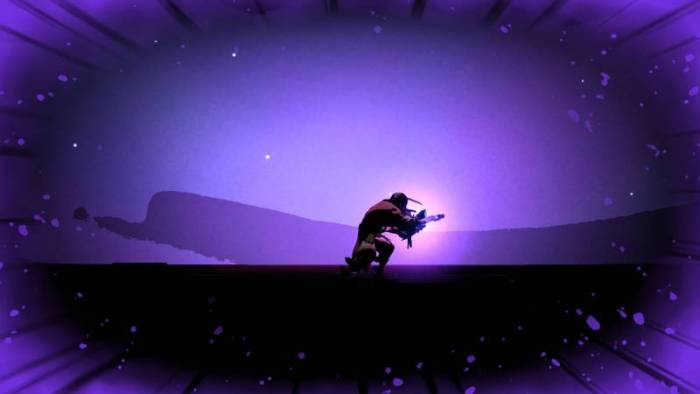
Pictured: You finding your Dad’s adult literature stash
What’s The Quick and Dirty on Curse of the Dead Gods?
Curse of the Dead Gods in a sentence is a roguelite dungeon runner that takes influence heavily from indigenous South and Central American mythology. You play as a grandpa-ass explorer (apparently, his name is Caradog) who is undoubtedly stuck in this tomb due to a search for riches and glory that do not belong to him.
Food for thought, what differentiates an archaeologist from a grave robber?
Anyway, there isn’t really a narrative focus to this game. Consider it more of a backdrop that points you in the right direction.
For better or for worse, the masterpiece known as Hades has lifted the expectation for action roguelites with its compilation of design, engaging gameplay, and incredible story so it’s understandable that some may find Curse of the Dead Gods a little shallower by comparison.
I, for one, think that not having a story didn’t do this game a disservice.
The explorer finds before them a door of massive size that hums with an ominous energy. He ventures in with his trusty blade and pistol, but upon finding death waiting for him, he always finds himself in the same room facing the door once more.
It’s this relentless Sisyphean purgatory that connects it all, and to be honest, further elaboration is, therefore, unnecessary.
It’s a poetic struggle up the mountain, with each adventure promising riches and/or escape but only resulting in, at worst, death or, at best, a return to the very place you began.
The hope of escape perpetually shattering against the cliffside is torture in of itself, and perhaps that’s all we need to really understand here.
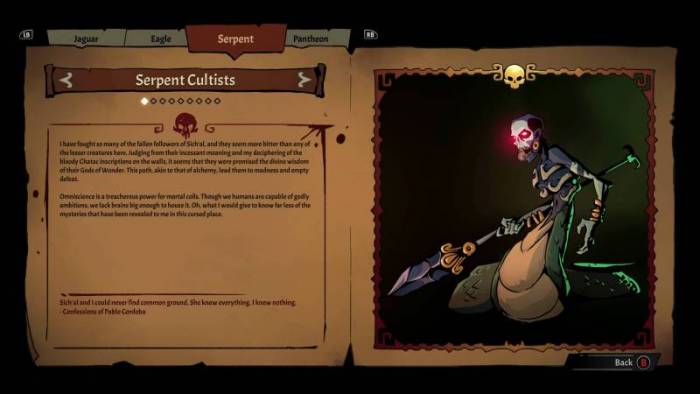
If you choose to dig into the lore of Curse of the Dead Gods via journal entries, please feel free to do so at your leisure.
I decided to invest my time doing other things instead, like eating copious amounts of barbecue and sanding down my toenails. To each their own.
OK, So What’s Randomised Each Run?
For a game with basically no voicework or storyline, you’ll be pleased to know that the gameplay systems are deceptively intricate.
First, the Map Layout changes every time.
The player is given the choice of which tomb to enter and, subsequently, which guardian they will meet at the end of the labyrinth. As tombs are vanquished, higher-difficulty ones are made available to enter.
There are three distinctive “biomes” that correspond to a Jaguar (Red), Eagle (Blue), and Snake (Green). Passtech did a really great job making each of these feel distinctive in terms of hazards and enemy composition, although their balancing of challenges wasn’t exactly the most egalitarian. More on that later.
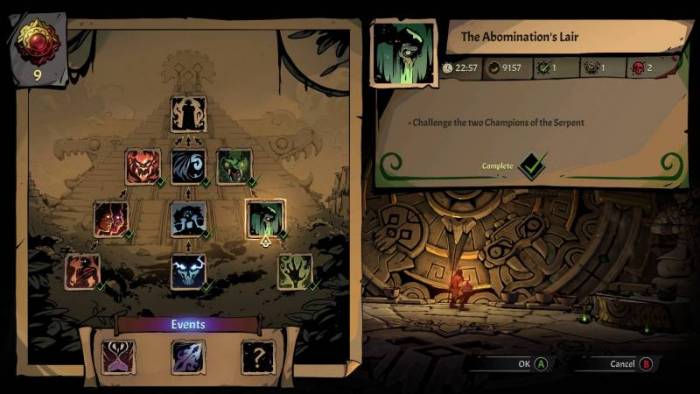
The expeditions into the various temples increase in difficulty by essentially tacking on another dungeon and hardcore boss right after the one you complete.
At the bottom tier, you are tasked with fighting your way up to a singular champion or minor boss, but the next highest on the chain will have you make your way through the tomb, fight that champion, then do it all over again with a separate one.
While on a run, you do not reset what you’ve gained in terms of abilities and weaponry, but you will retain any damage or debuffs you’ve received.
This trend continues until you reach the peak, where you have to fight through three temples vanquishing three corrupted avatars (the big bads) in succession and then take on the avatar of death, who is stupidly named Clovis.
Regardless if you pick the same tomb twice in succession, the map paths available to you will be different, and subsequently, the rooms within will likewise be switched up.
Each “section” will be represented on the map with an icon that denotes what completing it will grant you. For example, a stack of coins obviously denotes that you’ll find ample amounts of gold within this part of the tomb, whereas a red skull mask indicates a champion enemy will be waiting to slap you around a little.
The ones I tend to beeline for are the three stone animal heads that indicate you can boost your core attributes at that location.
You have constitution (impacting total health), dexterity (impacting damage output), and perception (impacting how much gold you find lying about). Typically I find that these are worth the cost.
Like any roguelite dungeon crawler, it is important to study what the optimal path is for your current playthrough’s build, and because of this, every time is a little different.
But why does the path you take matter, and why does adding another chunk of rooms to crawl through make it that much more difficult than you’d expect? Well, that’s because of the second key randomized variable.
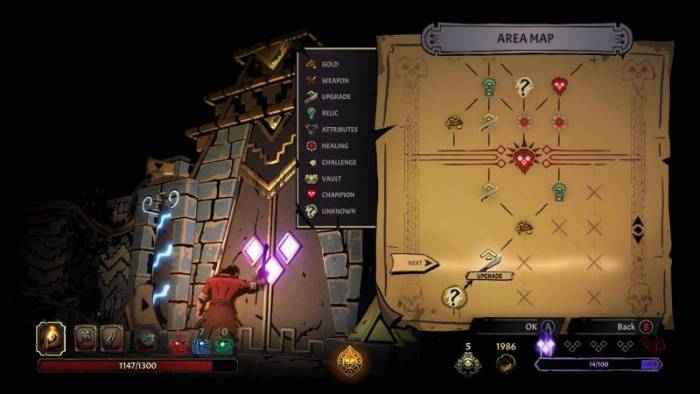
Good clean UI is to die for
CURSES!
This is where the game truly deviates from other titles in this genre in that you are subject to a secondary hazard that is impossible to guard against and will actively punish you while you progress.
On the bottom right of your screen, there is a purple bar with 5 icons above it. This represents how much corruption you have picked up traipsing your way through the dungeon.
With EVERY door you go through, meaning any time you move towards your ultimate goal, the explorer will receive a set value of corruption. An un-upgraded explorer will take a hit of 15 corruption in every tomb except for the pinnacles, as then that number doubles to 30.
Your threshold sits at 100 in most circumstances, so if you’re not careful, this racks up ridiculously fast.
This matters because upon hitting your limit of 100, upon exiting the room you’re in, the explorer will be subject to a random curse that could be anywhere from a mild inconvenience to absolutely devastating.
Think about the ramifications of this. Each temple area has around 8 room blocks to clear, so just based on that alone, you are accruing 1-2 curses depending on which tomb you pick just by moving along the path.
When you get to the top of each tomb segment, you will face a miniboss or a boss (denoted by a red skull), and that will allow you to get rid of a single active curse.
As you progress, enemies will get tougher to kill, and sometimes the optimal path doesn’t provide you with the equipment/upgrades to improve your character or the money to purchase said upgrades.
Thankfully (or not), corruption can also be used as a resource to offset a lack of gold.

Three options every time
At these points of interest, if you haven’t collected enough cash, you can actually acquire the item or boon with corruption. I’ve had some runs where even on the first section of a tomb, I’ve racked up three curses due to what some would call “reckless gambling with my corruption meter” because I’m a greedy pig of a player, but you have to weigh the pros and cons of these actions yourself.
The impact of a curse will depend on your playstyle and build.
For example, the worst curse, in my opinion, are the ones that make enemies unpredictable by, let’s say, sometimes exploding on death and sending a ring of lightning out around the arena that must be dodged. That is one I prioritize eliminating immediately.
By comparison, one that’s not in my “shit yourself” tier is a curse that makes you take more damage until you kill 30 enemies but gives you 50% increased movement speed.
Personally, I like zooming around committing atrocities on the temple denizens, so I considered it more of a side quest to reap a reward as opposed to a punishment. You’ll quickly develop a positive or negative Pavlovian response when a curse pops up based on experience.
You can be subject to a maximum of five curses at a time, and while the first four are random, the final one always has the same effect. Upon receiving it, your health will gradually tick downwards until it reaches 1 hp, effectively making it a “hitless” run from then on.
I have never gotten that curse, so I cannot speak to how quickly your health depletes, but even the concept of it is terrifying to me, as Curse of the Dead Gods is one of the most chaotic action roguelites I’ve ever played.
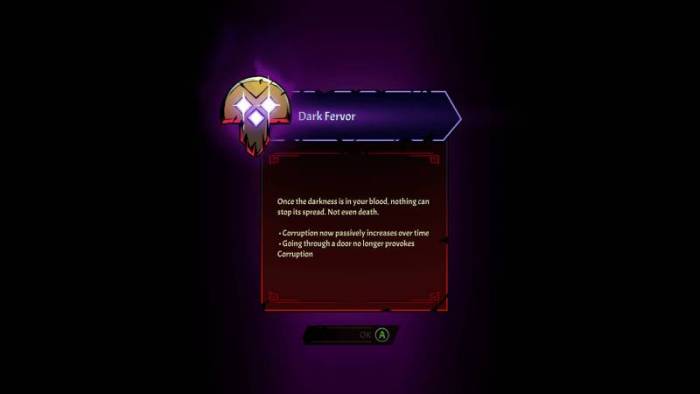
This one sucks too, but it’s the leading name for my upcoming cookbook
Before you jump into a temple, your starting weapons are also randomized in the entrance hall. You get a primary, a secondary, and a heavy weapon provided, and there are an array of forms/types that perform differently.
I won’t go into all of them because that would take ages, but there is a decent amount of variety to be seen.
What makes it even more interesting is that not only will a claw perform differently from a sword, each sword will have an ability unique to that form factor.
As you upgrade your initial weapon selection (more on that below), your starting options will additionally be buffed with extra modifiers and traits that change the way they can be used.
A claw that does +20% critical damage is nice but has a completely different set of priorities in terms of player upgrades when compared to a claw that gets increased damage based on your perception stat.
If you choose the latter, for instance, you will be on the lookout for items or upgrades that boost your perception stat over all others to complement the synergy available.
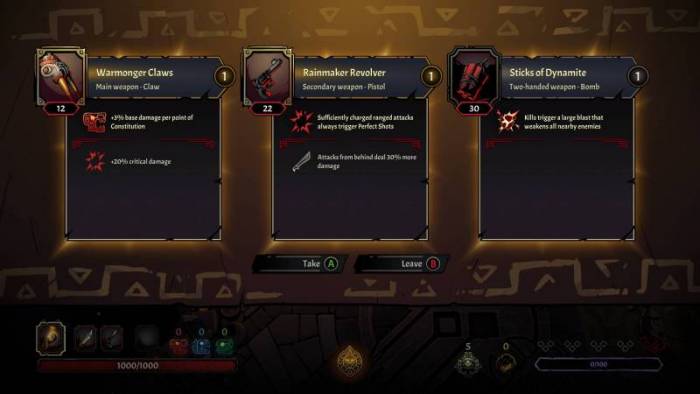
When killing enemies, they will sometimes drop additional weaponry and relics that you can equip should you choose. All their traits are likewise random, so don’t be rushed to pick up something just because you have a free slot.
While that may work in the earlier floors, having a synergistic build is something you must keep in mind as you venture deeper into the tomb.
There are a lot of variables constantly in flux, but strangely, once you get the basics down, Curse of the Dead Gods does a good job of providing you with the tools to consistently dive deep into the tombs. So…
How Do You Assert A Modicum of Control Over the Carnage?
Well, let’s start out with what you can immediately impact, your movement, attacks, and stamina management.
Your explorer has a standard 5 ticks of stamina that they can expend to perform attacks and dodges. Completing a combo with a weapon will drain one dot, and so will rolling to avoid an attack. Enemies will flash orange when they are about to attack, but each of their timing will be slightly different, so be mindful of that.
Once you have depleted your stamina, nor will you be able to attack as fast. As you can imagine, this is less than ideal. I’m guilty of constantly forgetting to check how many ticks of stamina I have remaining and, subsequently, have been caught with my pants down quite often.
You can also parry most attacks by timing the button the moment an enemy hit connects with you, but typically that is a lot less reliable than using a dodge roll. The advantage is that a successful parry will leave the enemy weakened, meaning they will take increased damage for a short period of time.
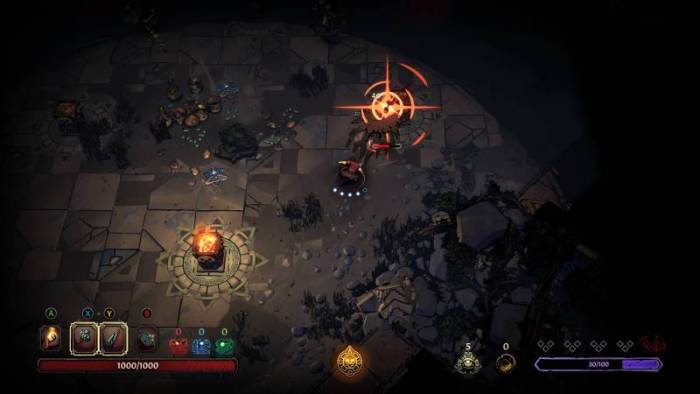
In terms of combat, that’s pretty much it. It’s simple, and it’s reasonably clean, but dodging multiple enemies and traps makes it hard to master.
As you explore, you will pick up resources that you can spend at the entrance hall to upgrade several key components that will set you up for success on future runs.
The main two are crystal skulls and jade rings, with the last being emblems. Emblems are the least important and just mark your completion of specific tombs, allowing you to access higher-difficulty ones.
Jade rings are the next most important as they unlock additional weapon options that will be added to the pool that you can find randomly in the temples or in the entrance hall.
While this may seem fun (and it is), on a larger scale, games of this nature sometimes run into an issue where enabling more options dilutes the pool to such an extent that the truly top-tier equipment becomes harder to come by.
You see this in other action roguelites like Dead Cells. There is always a tier list as to which weapons are effective and which are absolute dogshit. An artificial way to make games harder is to make it so the effective ones show up less often so that you’re handicapped with something garbage more often.
Curse of the Dead Gods actually allows you to, after unlocking a new weapon, banish it from the weapon pool if you desire. This is a great way to make the randomness a little more manageable, in addition to tailoring a game to a player’s unique preferences and playstyle.
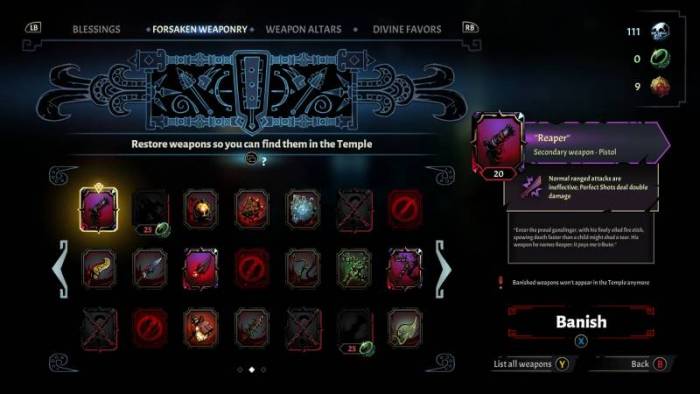
Resources in the top right corner, with banished weapons red circled
Crystal Skulls are the most valuable because they expand on literally everything else. They are responsible for increasing the number of initial load-outs you can select from, increasing the chance that your starting weapons have special effects and modifiers, and increasing the number of rerolls you can use at various altars or shops.
These may seem small peanuts to the smooth-brained reader, but think of it this way: Every single decision and path you take in Curse of the Dead Gods comes at the cost of making an alternate decision.
Having a better starting weapon enables you to have more options because if there’s only one choice, and it’s ass, what the f*ck are you going to do about it?
Just like any dice game, having more bites at the apple drastically makes your life better, so I don’t know about you, but I’d prefer twelve chances at an awesome weapon (three per starting weapon altar: a primary, a secondary, and a heavy) as opposed to just three. Not having to find a better one means that you can spend more time acquiring other resources like gold.
The final thing crystal skulls can be used for are Blessings.
I’ve said this a few times, so bear with me, but these can also drastically change how you conduct your dungeon run.
For example, two blessings I nearly always take are one that heals 50% of your health after defeating a miniboss/boss and one that makes boss battles drop 5 items to pick from as opposed to just 2 as a reward for vanquishing them.
Just to give you an example and to keep in theme with what we just discussed regarding the cost of our choices, here is how my train of thought works in this case. I like to take short-term risks for long-term rewards; therefore, I make a beeline for stat upgrades that I may not have the funds to pay for.
Stat upgrades are eternal, are cheap on the beginning nodes, and you can get two boosts at a time. Therefore, I typically am very liberal at the beginning floors where things are peachier in not giving a shit whatsoever how much corruption I accrue grabbing these core upgrades.
However, doing your best impression of a gambling stinky Wall Street mofo means you get curses, and curses are annoying! Even if the ones you get don’t do much to you, it’s the principle of things, you know?
Therefore priority number 2 in my playthroughs after finding stat upgrades is to beeline toward minibosses.
With this strategy, minibosses not only wipe away a curse but restore a bunch of health (meaning you don’t have to sacrifice upgrades for healing rooms) but also drop 5 pieces of gear to sort through. The ones I like, I keep. The ones I don’t, I trade in for extra resources.
Provided you don’t get your ass kicked, this is a viable way to maximize returns but is entirely unique on my playstyle.
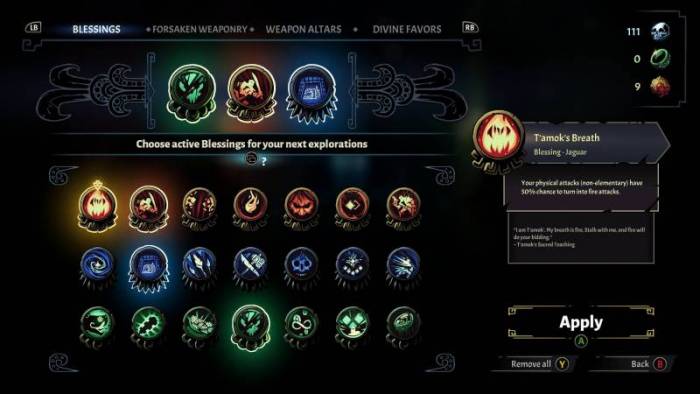
Anyway, I feel that giving these benefits made the game enjoyable even as I completed most of the dungeons. Personally, I’m a huge fan of player agency and customization, so this definitely enhanced the experience overall.
The final thing the player can control during their runs is whether they are fighting in the Light or in the Dark.
The explorer carries a torch that can illuminate a small area around them and spark up ambient light sources in the environment. When in the light, damage taken is decreased, but perhaps more importantly, you will be able to see the hidden traps lying around all over the place in the various dungeon rooms.
From statues that come to life and take a Babe Ruth swing at you, to electric landmines, to jaguar heads that shoot spikes; you need to be constantly aware of what is a live trap and what is merely a decoy.
Only in the light are you able to see these hazards, as in the dark, they all look inert. Some weapon aspects increase the explorer’s damage in the dark, but that’s for experienced players to worry about, not you noobs.
Criticism of Curse of the Dead Gods
When it comes to roguelites, Curse of the Dead Gods did a lot of things right. The art style is unique and vibrant, when you can see it; there is a ton of replayability, and the unlocks are intriguing. That’s not to say it’s my favorite game in the genre, however, and here are some reasons why.
I’d say my biggest issue with the game is that you really can’t see shit.
Yes, the light and dark mechanic is a core facet of the experience, and yes, when it’s dark, it can get DARK, but that’s not what I’m referring to.
If you take a look at the image below, you’ll notice how based on where the character is positioned that you don’t have vision of enemy movement for pretty much the top fourth of the screen. What’s more, the bottom fourth of the screen is cluttered with icons, meaning that your ability to react to threats in that quadrant is also hampered.
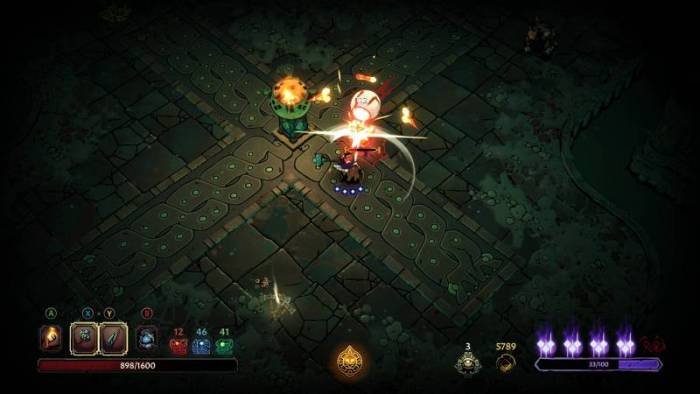
Side note: Notice how many curses I’ve stacked up?
What you can visually see follows your character’s movements, and your camera cannot be adjusted to give you a little more room. The problem with this is that enemies in this game are numerous, and some have an incredibly long range.
I’ve often been hit by a long-range shot or a jump attack that came from the top of the screen that I never actually saw the windup for.
You may say that this is part of the challenge, but I think giving the player a chance to react is a core component of this genre. Curse of the Dead Gods sacrifices this for some reason and makes it feel like you get cheap-shotted more often than not.
For comparison, in other action roguelites like Hades, the character is smaller, and you get a larger awareness of the map. In the image below, you can clearly see where you are in relation to your targets, giving you ample time to get out of the way or respond. Hades being one of my all-time favorites aside, this is a clear design error for Curse of the Dead Gods; dare I say, it’s a MOST crippling flaw.
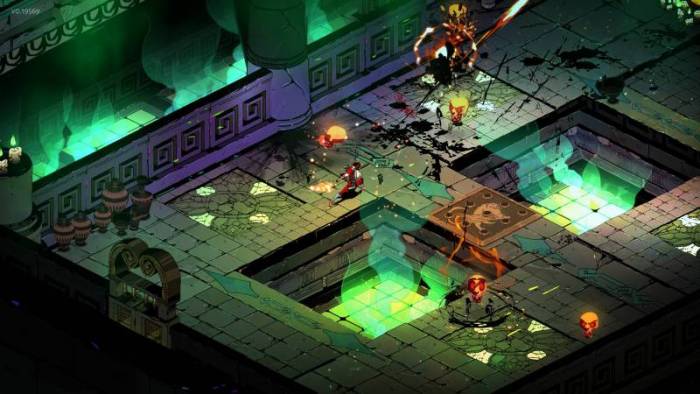
Credit: Supergiant Games
Secondly, the tombs themselves are not balanced. The Jaguar and Snake tombs can be difficult, but the Eagle levels are so far and beyond in terms of being a pain in the ass that it’s almost like they’re in their own game. It’s such a juxtaposition that every single aspect of those particular dungeon runs is a nightmare to deal with.
The traps: Invisible landmines that don’t have an “inert” state, so you can’t predict where they’ll be without a torch, Bird statues that send gusts of wind to follow you around, and runic eggs that get supercharged with environmental effects and send beams of energy around the room. These rooms are small, and as written above, your vision is limited. It’s rough.
The enemies: The most sorry bunch of twats you’ll ever meet. A baby that teleports and blows shit up with lightning and a swordsperson that can leap across the screen and has such a delayed attack animation that you will be caught off guard unless you’ve practiced are just two of the particular brand of wankery going on in blue temples.
You will learn to hate them as I do.
The bosses: They teleport, they spawn storm clouds that shock you, they hide in the storm clouds so you can’t hit them, they supercharge lightning beams at you that you can’t escape from if you’re caught….the list goes on.
In particular, the Dark Avatar of the Eagle is an absolute bastard who turns the entire arena into a disaster zone.
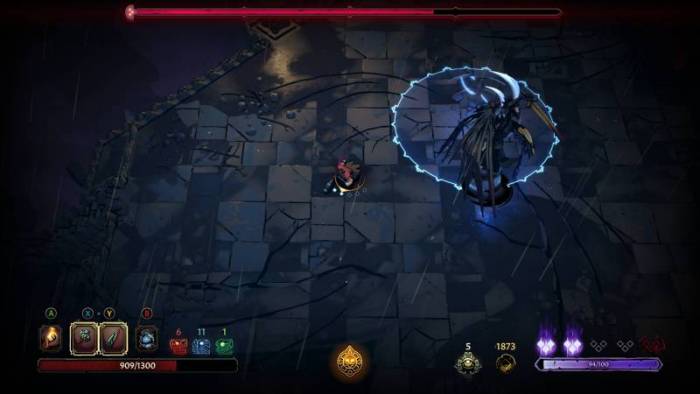
He’s going to take a swing, but also, that blue ring is about to explode. Two attacks for the price of one.
Now don’t get me wrong, I can beat these levels, but I actually get relieved when it’s any other temple, and that strikes me as weird there is one design so much worse than all the others.
A much smaller other critique is that while the sprite designs are wonderful, the individual sub-area layouts get repetitive at a certain point.
While the winding corridors are filled with hazards, I got tired of the meandering due to the relative monotony of scenery. As you get further into the temples, the development team definitely added a few morbid elements like impaled bodies and skulls.
However, this isn’t enough to shake me out of the doldrums, and I longed for sub-areas that were just a single room spawning waves of enemies so I wouldn’t have to wander around in shit I’d seen a million times.
My final criticism is another small one, but it’s how the cadence of the final big bad is set up.
As a reminder, in the pinnacle temple runs, you fight through all three other minor avatars and their champions to reach the Champion of Death himself; Clovis Pardieux.
It can be grueling, it’s a marathon, but with enough practice, you will body your way up to the temple top…only to be greeted by three stone slabs representing the three corrupted gods you know so well.
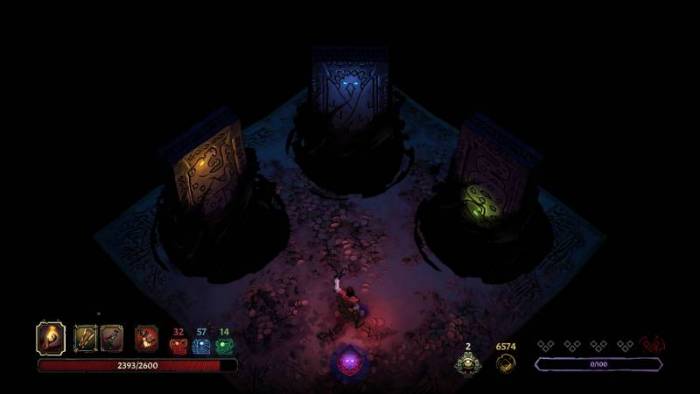
In order to progress, you will have to interact with each of these steles and pay the appropriate fee. Like every other choice, you get three options, and they come at a hefty cost this time.
This isn’t one of those situations where not taking something is a choice, as picking the free option imposes a debuff on the explorer that can be horrific to bare.
For example, not being able to absorb the gold cost of the green idol will DESTROY your two highest-level relics. Yes, you read that correctly…destroy. When 40% of your relics (and the two most powerful to boot) suddenly go up in smoke, it’s a huge power decrease.
The next highest tier costs 2500 gold and will put the player through a little “hard to get” bullshit by buffing one thing and debuffing another. For example: randomly deciding whether to heal or inflict 10% of your health bar.
The most expensive tier is 5000 gold, and it has incredible benefits, like boosting all your relics by one level.
You’ll quickly learn which of these you should prioritize if you’re on a budget, but of course, this means that for your entire last temple, you will want to save up as much gold as possible, and for a first-timer who is unaware of what is in store, it can be very deflating.
While I understand the need to impose a final challenge on the player, I would have liked there to be another way to pay for the items if you don’t have the cash.
Perhaps unique final curses that don’t appear anywhere else in the temple, with a hefty dose of corruption to boot, would have been a more “fun” way to hamstring us instead of flat gold costs.
Fighting Clovis is also a trip because he has some really wild shit to him.
More than at any other point in the game, you realize the limitations imposed based on what you are able to see because Clovis darts all over the place, switches up attack patterns and weaponry at the drop of a hat, and hits like a tank.
One of his attacks involves shooting a homing arrow at you that flies OFF SCREEN as it goes by, only for it to boomerang back. Half the time, you can’t see it turn around, so you’ll be caught by surprise. Clovis will not sit still like a good boy and instead will be bum-rushing you with an axe or rapid-fire arrows at the same time.
Being the final boss of a grueling temple run, you can’t practice against the prick that often, so if you’re not overpowered or really “with it”, you’re going to have a bad time. I enjoy the suffering, but I can see it putting people off.
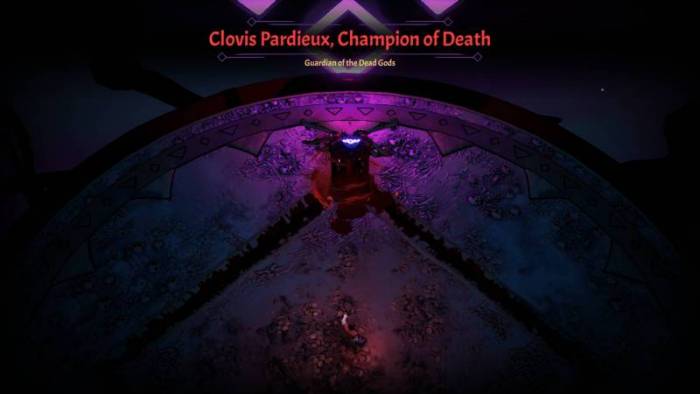
Figures he’d be French, though.
So, Should You Play Curse of the Dead Gods?
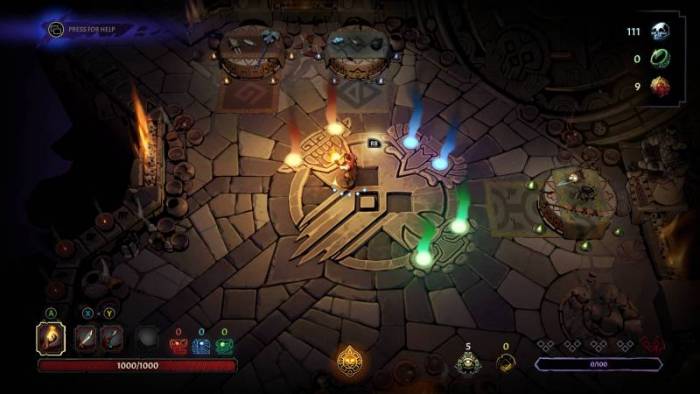
What we have here is a decent addition to the genre. Curse of the Dead Gods has got a distinct style, the weapon system is appealing and doesn’t fill up the available pool with trash, and the corruption mechanic makes it so you’re always operating on a clock.
From the Ravenswatch gameplay I’ve been observing from other creators, I think they’ve taken a lot of the good from Curse of the Dead Gods and are working on implementing it into their new game, so I’m not worried about that aspect.
What does concern me is that they seem to be keeping in line with the same angle and framing of your character vs the environment, meaning the main issue I see here will likely be present in that as well. Just something to keep in mind.
In any case, Curse of the Dead Gods is a 3/5 game that you should give a shot if you want a tight combat experience with unique punishment aspects and above-average progression mechanics that breaks the mold in some key aspects of the action roguelite genre.
Curse of the Dead Gods sells for $19.99; it is available from Steam, Epic, gog.com, Focus Entertainment, and others.
Developer: Passtech Games
Publisher: Focus Entertainment
Source: Personal Purchase
What I Like: Smooth combat performance; Ability to play your own style with a mixture of weapons and blessings that suit you; Progression actually makes you stronger instead of throwing in more chaff
What Needs Improvement: Framing of the camera means you get blindsided a lot; Tepid and rigid final boss mechanic; Subpar balancing for one specific temple (1/3 of the game)

This seems like a nice, entertaining game. Thanks for the thorough and detailed review!
Personally, roguelites aren’t my thing, though the name interested me. The pros and cons list at the top was appreciated.